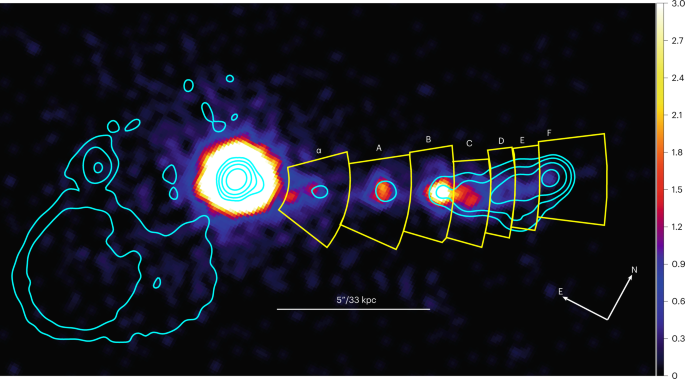- Select a language for the TTS:
- UK English Female
- UK English Male
- US English Female
- US English Male
- Australian Female
- Australian Male
- Language selected: (auto detect) - EN
Play all audios:
ABSTRACT During the night of August 15—16, 1947, radio echoes were obtained apparently arising from a luminescent cloud which appeared near the end of an aurora streamer. The apparatus,
which has been described elsewhere1,2, was in use for the study of meteoric ionization simultaneously on frequencies of 72 Mc./s. and 46 Mc./s. At Aug. 16d. 00h. 10m. U.T., an echo was
observed intermittently on the 46 Mc./s. equipment at a range of 480 km. By 00h. 20m. the amplitude had increased to three times the normal noise-level. It then decreased with slow
fluctuations in intensity, and after twenty minutes was lost in the noise-level at 00h. 30m. U.T. A second echo appeared at 460 km. range at 00h. 25m. U.T. and lasted for four minutes. Also
at 00h. 10m. U.T., an increase in noise-level was apparent on both 72 and 46 Mc./s,. equipments over the range 450-600 km. The noise increase persisted and increased in range to 700 km. by
00h. 35m. U.T, when it disappeared. Simultaneously with the appearance of the echoes, a faint blue-grey auroral cloud appeared near the zenith at the upper tip of one of the streamers, which
were at that time covering the whole of the northern sky. The streamers receded from the zenith but the cloud grew in intensity, and at 00h. 35m. U.T. broke into nine striations and rapidly
faded. The radio echoes thus vanished when the cloud became striated. The entire aurora was visible from darkness on August 15d. to August 16d. 02h. 30m. U.T, but apart from the effects
recorded above no other unusual echoes were observed. Access through your institution Buy or subscribe This is a preview of subscription content, access via your institution ACCESS OPTIONS
Access through your institution Subscribe to this journal Receive 51 print issues and online access $199.00 per year only $3.90 per issue Learn more Buy this article * Purchase on
SpringerLink * Instant access to full article PDF Buy now Prices may be subject to local taxes which are calculated during checkout ADDITIONAL ACCESS OPTIONS: * Log in * Learn about
institutional subscriptions * Read our FAQs * Contact customer support SIMILAR CONTENT BEING VIEWED BY OTHERS ACTIVE AURORAL ARC POWERED BY ACCELERATED ELECTRONS FROM VERY HIGH ALTITUDES
Article Open access 18 January 2021 OPTICAL EMISSIONS ASSOCIATED WITH NARROW BIPOLAR EVENTS FROM THUNDERSTORM CLOUDS PENETRATING INTO THE STRATOSPHERE Article Open access 17 November 2021
LIGHTNING AT JUPITER PULSATES WITH A SIMILAR RHYTHM AS IN-CLOUD LIGHTNING AT EARTH Article Open access 23 May 2023 REFERENCES * Prentice, Lovell and Banwell, _Mon. Not. Roy. Ast. Soc._, in
the press. * Lovell, Banwell and Clegg, _Mon. Not. Roy. Ast. Soc._, in the press; see also _Nature_, 159, 119 (1947) and 160, 75 (1947). Google Scholar * Appleton and Builder, _Proc. Phys.
Soc._, 45, 208 (1933). Article ADS Google Scholar * Störmer, _Terr, Mag. and Atmos. Elect._, 501 (Dec. 1946). * For example, Appleton, Naismith and Ingram, _Phil. Trans._, 236, 191
(1937). Article ADS Google Scholar * Pierce, _Phys. Rev._, 71, 88 (1947). Article ADS CAS Google Scholar Download references AUTHOR INFORMATION AUTHORS AND AFFILIATIONS * Physical
Laboratories, University, Manchester, A. C. B. LOVELL, J. A. CLEGG & C. D. ELLYETT Authors * A. C. B. LOVELL View author publications You can also search for this author inPubMed Google
Scholar * J. A. CLEGG View author publications You can also search for this author inPubMed Google Scholar * C. D. ELLYETT View author publications You can also search for this author
inPubMed Google Scholar RIGHTS AND PERMISSIONS Reprints and permissions ABOUT THIS ARTICLE CITE THIS ARTICLE LOVELL, A., CLEGG, J. & ELLYETT, C. Radio Echoes from the Aurora Borealis.
_Nature_ 160, 372 (1947). https://doi.org/10.1038/160372a0 Download citation * Issue Date: 13 September 1947 * DOI: https://doi.org/10.1038/160372a0 SHARE THIS ARTICLE Anyone you share the
following link with will be able to read this content: Get shareable link Sorry, a shareable link is not currently available for this article. Copy to clipboard Provided by the Springer
Nature SharedIt content-sharing initiative







